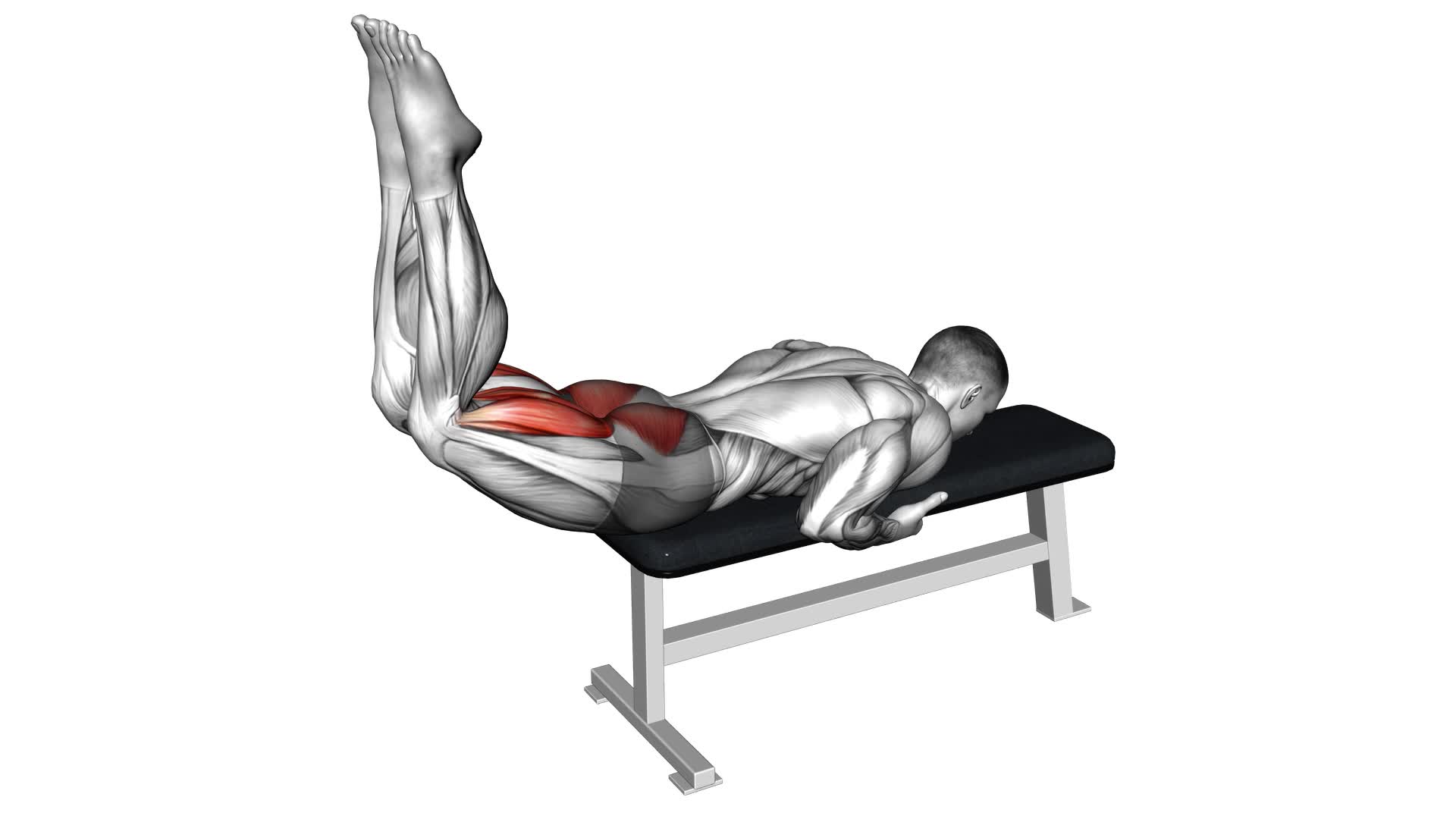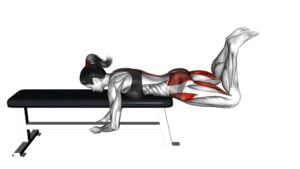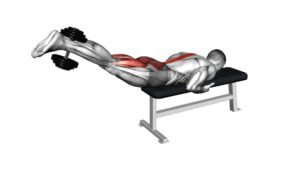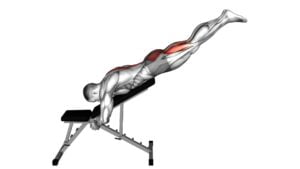Reverse Hyperextension on Bench – Video Exercise Guide & Tips

Looking to strengthen your lower back and glutes? Check out this video exercise guide for reverse hyperextension on the bench!
Watch This Exercise Video
You'll learn the proper form and technique, along with tips for maximizing the effectiveness of the exercise.
Whether you're a beginner or advanced fitness enthusiast, this guide has modifications for all levels.
Avoid common mistakes and get the most out of your workout with this informative and concise video guide.
Let's get started!
Key Takeaways
- Reverse hyperextensions on a bench target the lower back muscles for strength and stability.
- Engaging the glutes, hamstrings, and spinal erectors during this exercise helps strengthen the posterior chain.
- This exercise improves posture, alleviates imbalances caused by prolonged sitting, and promotes proper spinal alignment.
- Modifications and variations can be made to target specific muscle groups and increase the difficulty of the exercise.
Benefits of Reverse Hyperextension on Bench
You can experience multiple benefits from incorporating the reverse hyperextension on the bench into your workout routine. This exercise primarily targets your lower back muscles, providing strength and stability to your core. By engaging your glutes, hamstrings, and spinal erectors, you can develop a strong posterior chain, which is essential for overall functional fitness.
One of the key benefits of the reverse hyperextension on the bench is its ability to improve your posture. As you strengthen your lower back muscles, you can alleviate any imbalances that may have developed from prolonged sitting or poor posture habits. This exercise also helps in reducing lower back pain by providing support to your spine and promoting proper alignment.
Furthermore, the reverse hyperextension on the bench offers variations that can target different muscles and add variety to your workouts. You can modify the exercise by adjusting the angle of the bench or incorporating resistance bands or weights. These variations allow you to target specific muscle groups, such as your glutes or hamstrings, and challenge yourself as you progress in your fitness journey.
Incorporating the reverse hyperextension on the bench into your workout routine can bring numerous benefits, including improved posture, reduced lower back pain, and the ability to target specific muscle groups through variations. By consistently incorporating this exercise into your workouts, you can strengthen your core and achieve a well-rounded, functional physique.
Equipment and Setup for the Exercise
To properly set up for the reverse hyperextension on a bench, you'll need to consider three key points.
First, make sure the bench is at the right height for your body.
Second, gather the necessary equipment, such as ankle straps or a weight belt.
Proper Bench Height
Adjust the height of the bench to ensure proper equipment and setup for the exercise.
The bench height is crucial for maintaining proper form during the reverse hyperextension. When setting up the bench, make sure it's at a height where your hips can comfortably rest on the edge without any strain on the lower back.
A good starting point is to set the bench at a height that allows your legs to hang freely off the edge. This will help maintain the correct alignment of your body during the exercise. Adjust the bench height as needed to find the most comfortable and effective position for your body.
Necessary Equipment for Setup
To properly set up for the reverse hyperextension on the bench, ensure you have the necessary equipment and setup in place.
First, you'll need a sturdy bench that's preferably adjustable so you can modify the angle to suit your comfort level. Make sure the bench is stable and can support your body weight.
Additionally, you'll need ankle straps or a footboard attachment to secure your feet in place during the exercise. This will prevent any unwanted movement and help maintain proper form.
Lastly, it's important to have a mat or cushion to place on the bench for added comfort and support.
Adjusting Foot Placement
To properly position your feet for the reverse hyperextension on the bench, use ankle straps or a footboard attachment to secure them in place. This ensures stability and prevents your feet from slipping during the exercise. Adjusting your foot placement correctly is essential for maximizing the benefits of the exercise and maintaining proper form.
Here are three key points to keep in mind when adjusting your foot placement:
- Place your feet hip-width apart on the footboard or beneath the ankle straps.
- Keep your toes pointing forward throughout the movement.
- Position your feet so that your heels are slightly hanging off the edge of the bench, allowing for a full range of motion.
Proper Form and Technique
How can you execute the reverse hyperextension on the bench with proper form and technique? When performing this exercise, it's crucial to maintain the correct form and technique to maximize effectiveness and prevent injuries.
To begin, position yourself face down on the bench with your hips just beyond the edge. Place your legs on either side of the bench, allowing them to hang freely. Bend your knees slightly to create a stable base.
Next, engage your core and glutes as you lift your legs upward, aiming to create a straight line with your body from your head to your heels. Be sure to avoid excessive arching of your lower back and focus on using your glutes to power the movement.
Throughout the exercise, it's important to maintain control and avoid using momentum. Slowly lower your legs back down to the starting position, maintaining tension in your glutes and core. Remember to breathe steadily throughout the movement.
By executing the reverse hyperextension on the bench with proper form and technique, you can effectively target your glutes while minimizing the risk of injury.
Now, let's explore modifications for different fitness levels.
Modifications for Different Fitness Levels
For individuals at varying fitness levels, there are modifications available to adapt the reverse hyperextension on the bench exercise. Whether you're a beginner or an advanced athlete, these modifications can help you progress and prevent injuries.
Here are three options to consider:
- Adjusting the bench height: If you're just starting out or have limited mobility, you can lower the bench height to make the exercise more accessible. This modification allows you to perform the movement with less strain on your lower back and hamstrings.
- Using resistance bands: To increase the difficulty of the exercise, you can incorporate resistance bands. Attach the bands to the bench and place them around your ankles. This will add tension and require more effort from your glutes and hamstrings.
- Adding weight: As you become more comfortable with the exercise, you can challenge yourself by adding weight. Hold a dumbbell or a weight plate against your chest while performing the reverse hyperextension. This progression option helps to further strengthen your posterior chain.
Common Mistakes to Avoid
To avoid common mistakes during the reverse hyperextension on the bench, it's crucial to maintain proper form. Incorrect form can lead to injury and strain on your back.
Additionally, neglecting to warm up properly before performing this exercise can increase discomfort and potential injuries.
Improper Form Risks Injury
When performing the reverse hyperextension on the bench, it's important for you to be cautious of improper form, as it can significantly increase the risk of injury. To ensure injury prevention and correct body alignment, keep the following points in mind:
- Maintain a neutral spine throughout the exercise, avoiding excessive arching or rounding of the back.
- Engage your core muscles and squeeze your glutes to stabilize your body and prevent strain on your lower back.
- Use controlled movements, avoiding any jerking or swinging motions that can put stress on your joints.
By following these guidelines, you can minimize the risk of injury and maximize the effectiveness of the exercise.
Transitioning into the next section, neglecting warm-up increases discomfort, it's crucial to prepare your body properly before engaging in any exercise routine.
Neglecting Warm-Up Increases Discomfort
By neglecting to warm up before performing the reverse hyperextension on the bench, you increase the risk of discomfort and hinder the effectiveness of the exercise.
Warm up is of utmost importance when it comes to injury prevention and maximizing the benefits of your workout. A proper warm-up routine helps increase blood flow to the muscles, loosens up the joints, and prepares your body for the physical demands of the exercise.
Neglecting a proper warm-up can lead to muscle tightness, decreased range of motion, and even strain or injury. To avoid these issues, take a few minutes to perform light cardio exercises such as jogging or jumping jacks, followed by dynamic stretches that target the muscles involved in the reverse hyperextension.
Tips for Maximizing the Effectiveness of the Exercise
To maximize the effectiveness of the exercise, focus on maintaining proper form and engaging your core throughout the reverse hyperextension on the bench. Here are some tips to help you get the most out of this exercise:
- Keep your body in a straight line from head to toe. Avoid arching your back or letting your hips sag.
- Squeeze your glutes at the top of the movement to fully engage your posterior chain. Imagine trying to lift your legs as high as possible.
- Control the movement on both the way up and the way down. Avoid using momentum to swing your legs.
By following these tips, you can maximize the results of the reverse hyperextension on the bench.
This exercise primarily targets your glutes, hamstrings, and lower back. However, you can also make variations to target different muscle groups. To focus more on your glutes, try using a resistance band around your ankles or using ankle weights. To target your hamstrings more, you can bend your knees slightly during the movement.
Frequently Asked Questions
How Many Sets and Repetitions Should I Perform for the Reverse Hyperextension on Bench Exercise?
To get the most out of the reverse hyperextension on bench exercise, it's important to determine the right number of sets and repetitions for you. By doing this exercise, you can experience benefits for lower back pain.
Start by discussing your goals and fitness level with a trainer or healthcare professional. They can help you determine the appropriate number of sets and repetitions based on your individual needs and abilities.
Can This Exercise Help With Lower Back Pain or Prevent Injuries?
Incorporating core strengthening exercises like the reverse hyperextension on bench can help with lower back pain relief and prevent injuries. Stretching exercises specifically targeted for the lower back can provide relief by increasing flexibility and reducing muscle tension.
Additionally, strengthening your core muscles can improve stability and support for your spine, reducing the risk of injuries. By regularly performing this exercise, you can experience the benefits of a stronger core and a healthier lower back.
Is It Necessary to Use a Bench Specifically Designed for Reverse Hyperextensions, or Can a Regular Bench Be Used?
When it comes to reverse hyperextension variations, you might be wondering if a regular bench will suffice or if a specialized bench is necessary.
Well, let me tell you that while a regular bench can be used, there are definite benefits to using a reverse hyperextension bench.
It provides better support and stability, allowing you to target your lower back muscles more effectively.
Are There Any Alternative Exercises That Can Target the Same Muscle Groups as the Reverse Hyperextension on Bench?
There are indeed alternative exercises that can target the same muscle groups as the reverse hyperextension on a bench. These exercises include the glute bridge, the standing hip extension, and the Swiss ball hamstring curl.
These exercises focus on strengthening the glutes, hamstrings, and lower back muscles, which are the same muscle groups targeted by the reverse hyperextension.
Incorporating these alternative exercises into your workout routine can provide variety and help you achieve your fitness goals.
Can This Exercise Be Performed Without Any Additional Weights or Equipment, Solely Using Bodyweight?
Yes, you can perform variations of the reverse hyperextension exercise without any additional weights or equipment, solely using your bodyweight. This exercise targets your lower back, glutes, and hamstrings, helping to strengthen and stabilize these muscle groups.
By incorporating the reverse hyperextension into your full body workout routine, you can improve your overall core strength, enhance your posture, and reduce the risk of lower back pain.
It's a great exercise to add to your fitness regimen.
Conclusion
In conclusion, the reverse hyperextension on a bench is a highly effective exercise for strengthening the lower back, glutes, and hamstrings. By following proper form and technique, individuals can maximize the effectiveness of this exercise.
It's important to start with lighter weights and gradually increase the resistance as fitness levels improve. Avoiding common mistakes and implementing the suggested modifications can help prevent injuries and ensure optimal results.
Incorporating the reverse hyperextension into your workout routine can contribute to overall strength and stability.

Author
Years ago, the spark of my life’s passion ignited in my mind the moment I stepped into the local gym for the first time. The inaugural bead of perspiration, the initial endeavor, the very first surge of endorphins, and a sense of pride that washed over me post-workout marked the beginning of my deep-seated interest in strength sports, fitness, and sports nutrition. This very curiosity blossomed rapidly into a profound fascination, propelling me to earn a Master’s degree in Physical Education from the Academy of Physical Education in Krakow, followed by a Sports Manager diploma from the Jagiellonian University. My journey of growth led me to gain more specialized qualifications, such as being a certified personal trainer with a focus on sports dietetics, a lifeguard, and an instructor for wellness and corrective gymnastics. Theoretical knowledge paired seamlessly with practical experience, reinforcing my belief that the transformation of individuals under my guidance was also a reflection of my personal growth. This belief holds true even today. Each day, I strive to push the boundaries and explore new realms. These realms gently elevate me to greater heights. The unique combination of passion for my field and the continuous quest for growth fuels my drive to break new ground.







